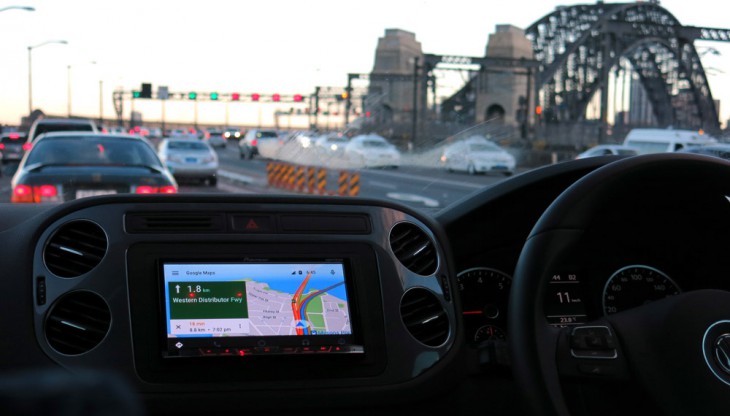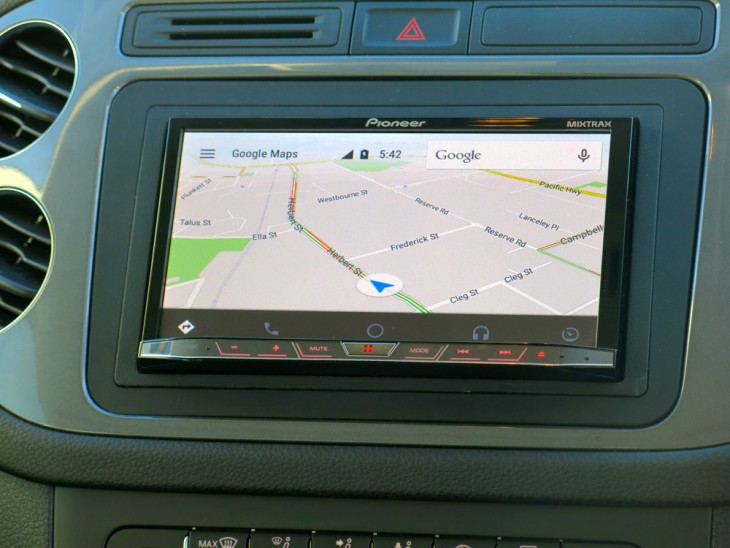
Since its first reveal at Google I/O 2014, Android Auto has been pretty quiet, with occasional comments and remarks from Googlers or developers making their way out to social networks or Reddit. That’s all changing now, with the platform’s official public unveiling last week and some 2.5 years of effort – including Australian Google engineers.
The first cars with Android Auto built in are still on their way, but Pioneer’s head units are the first third-party solution that can add Android Auto to your car, and they’re available now in Australia.
Pioneer’s Michael Broadhurst and Ben Crawford picked me up in a Volkswagen they drove up from Melbourne, fitted out with an AVH-X8750BT head unit to give me a first-hand look at Android Auto.
Connect and go
The AVH-X8750BT can be fitted into most modern cars with the aid of a dash kit (to ensure it fits the space available in your dash), and a CAN BUS adapter suitable for your car’s make and model. It can connect to your in-car CD player, control playback of audio files from USB, connect to devices via Bluetooth and do everything you expect your head unit to do, with the addition of support for Android Auto (and something else called Apple Car Play, but I’ve no idea what that is).
The CAN BUS adapter allows the head unit to control and respond to actions you perform like pressing the volume up/down buttons on the car’s steering wheel or changing climate control settings. This is more a function of Pioneer’s head unit than Android Auto specifically.
When you connect an Android phone running Android 5.0 Lollipop or above via USB, you’ll be prompted to install the Android Auto app. You can stash your phone wherever you like once the app is installed, because its home screen becomes a plain black screen with the words “Android Auto” on it – you’re not supposed to use your phone when driving, remember? Exactly where you keep the phone is up to you, and whoever installs your Pioneer unit. In our case, the USB cables ran into the glovebox, so we connected the phone and closed it up.
Along the bottom of the screen there’s a set of icons that somewhat apes Android’s on-screen buttons, except there’s five of them. Left to right there’s buttons dedicated for Maps, Phone, Home and Music, while the last button takes you to a screen that lets you exit Android Auto to get back to the Pioneer head unit’s menu system.
Interactions are mostly started by voice input, with Google’s now-familiar red voice input button ever present at the top right of the screen, only ever obscured by an “X” if a notification is displayed. Surprisingly, given the hot mess that is Android Wear’s voice recognition, Android Auto rarely missed a beat.
You can tap the red button to go into voice input, and your car’s CAN BUS adapter should allow the voice input button that sits on modern cars’ steering wheels to activate it as well, although that wasn’t the case with yesterday’s demo. Volume control from the steering wheel worked fine, though.
The Apps
Android Auto’s user experience has its roots in Google’s Material Design, which we’ve known to be the case for some time now. Apps built for it – at least, those installed on the demo phone yesterday – have a consistent UI with a main display and a Navigation Drawer icon to open up a menu of functions.
Aspiring to a hands-off driving expereince is all well and good, but sometimes you need the user to look at the screen to make a selection (for example, choosing a destination in Navigation). When that happens, there’s clear presentation of the options available with big buttons ready to tap with a finger and only the information that’s absolutely necessary is displayed.
Google’s being very selective about who it works with and which apps are allowed onto Android Auto at the moment, and the minimal UI design might well be a reason for this. The list of supported apps already includes a number of popular audio apps though like (unsurprisingly) Google Play Music, Spotify, Stitcher Radio and more. Australia’s own Shifty Jelly is represented in the lineup too – Pocket Casts is ready for Android Auto, right now and it’ll play your podcasts in your car!
On The Road
Michael and Ben had a pretty good groove going with their Android Auto demonstration routine, so I thought it best not to disturb them too much while they run through some of the headline features. We took a short drive around Artarmon as the guys did their thing.
The AVH-X8750BT head unit carries an RRP of $1149. You’ll need to find an appropriate CAN-BUS adapter for your car though, and you’ll probably need to get a kit to make the unit look at home in your dash. Pioneer seems very happy with the unit’s performance at retail so far – the initial shipment into Australia has sold out, and the second shipment is already mostly gone.
If you want to get your hands on one, Pioneer recommends shopping with specialist stores and Autobarn.

We’re looking to get our hands on a unit for a full review soon. In the meantime, if there’s anything you’d like to know about Android Auto or Pioneer’s AVH-X8750BT head unit, ask away in the comments and we’ll do our best to answer.




